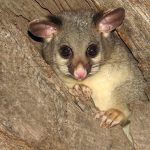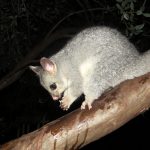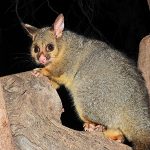COMMON BRUSHTAIL POSSUM
Sharon: My ‘Close Encounters’ with these beautifully coloured Coppery Brushtail Possums was from a tiny cabin set amongst the rainforests of Tropical North Queensland Australia. Very used to people they would come in each night, some with Bubs holding on tight, bushy and bright eyed. Such a delight to watch.
The Common Brushtail Possum: Nighttime Gardener of Australia
As the sun slips behind the gum trees and the air cools, a gentle rustling begins high above. Emerging from the shadowy hollows of an old eucalypt, a Common Brushtail Possum stretches, its large, dark eyes adjusting to the silver-blue glow of dusk. Its velvet fur—sometimes silver-grey, sometimes a deep earthy brown—blends seamlessly with the shadows, while the bushy black tail, furred on top and bare beneath, swings gracefully for balance.
High in the branches, the possum pauses, ears twitching as it listens for the soft calls of others. The scent of eucalyptus drifts on the breeze, mingled with the earthy aroma of leaf litter below. As it moves, the sharp claws on its clever paws grip the rough bark, each tactile sensation carefully registered, guiding the possum safely through its arboreal world.
Distinctive Features and Sensory Talents
- Size: Adults measure 32–58 cm, with tails adding another 24–40 cm; males are often larger, weighing up to 4.5 kg.
- Fur: Colours range from silver-grey to brown, highlighted by a cream patch on the forehead.
- Adaptations: The tail acts as a fifth limb, and sensitive paws help the possum feel its way through the night.
- Senses: Exceptional night vision, acute hearing, and a developed sense of smell make the possum a master of the nocturnal world.
Where Possums Call Home
The Common Brushtail Possum is a true survivor, thriving across Australia’s forests, woodlands, coastal scrub, and increasingly, in the heart of our towns and cities. By day, these marsupials curl up in tree hollows, leafy dreys, or, in urban areas, the dark security of a roof cavity. When darkness falls, they descend into the bush, gardens, parks, and suburban backyards, their presence marked by the soft scuffle of paws and the occasional flash of a bushy tail.
Diet: The Possum’s Feast
Possums are herbivores, and their menu is as varied as the landscapes they inhabit:
- Eucalyptus leaves are their staple, but they readily enjoy flowers, fruits, buds, and even tree bark.
- In cities, they sometimes sample garden plants or fruit left out by people.
As they forage, possums inadvertently act as nature’s gardeners, dispersing seeds and pruning foliage. This silent, nightly work supports healthy forests, helping new plants take root and flourish.
Life Cycle: Nurture Beneath the Stars
During the cool months from May to September, the possum’s story of new life begins. After a swift gestation of just 16–18 days, a tiny, underdeveloped joey is born and instinctively crawls into its mother’s pouch. Here, nestled in warmth, it will grow for several months before venturing onto its mother’s back—safe, yet exposed to the world—learning the skills of survival until independence calls.
Communication: The Soundtrack of the Night
The Australian night is alive with the calls of the Common Brushtail Possum:
- Growls, screeches, and hisses echo through the branches, signalling territory, warning rivals, or attracting mates.
- Their vocal repertoire, coupled with scent marking, ensures each possum knows its neighbours—and its boundaries.
Urban Adaptations and Coexistence
Possums have demonstrated remarkable intelligence and adaptability. In some cities, they’ve learned to open latches, navigate fences, and even exploit artificial lights for safety. While their presence can sometimes result in conflict—particularly when they nest in roofs or sample ornamental plants—responsible, humane management can foster peaceful coexistence.
- Secure roof spaces and provide nest boxes as alternatives.
- Observe, don’t feed—human food can harm possums and disrupt their natural behaviour.
Conservation and Respect
| Status | Notes |
|---|---|
| Not Endangered | Thriving in both wild and urban landscapes |
| Legally Protected | Cannot be taken or moved without proper authorisation |
Brushtail possums are a vital part of Australia’s ecological tapestry. By dispersing seeds and shaping plant growth, they help maintain the health of forests and urban green spaces.
A Shared Future
Picture a quiet garden under the Southern Cross, fragrant with the scent of gum leaves and resonant with the distant calls of possums. In this shared space, the Common Brushtail Possum is both neighbour and nurturer—a living reminder of the wild beauty that flourishes amidst our homes and hearts. By understanding their world and respecting their needs, we ensure that these resilient marsupials continue to thrive for generations to come.
Let us appreciate the Common Brushtail Possum not just for its adaptability, but for its essential role in Australia’s natural world. Through awareness and gentle stewardship, we all contribute to the ongoing story of our country’s unique wildlife.
Photo Gallery
Sharon: Every now and then you come across some lighter coloured Brushtail Possums. I have found some Golden Brushtails at various places around Australia from Zoos to the Wild.


























